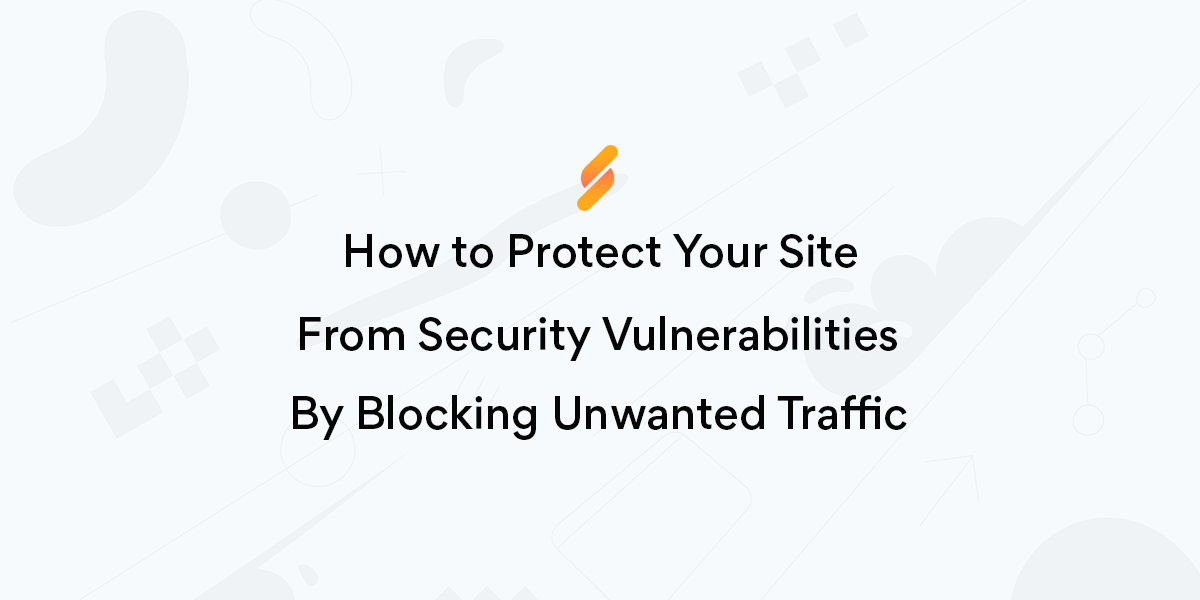Web traffic is the driving force behind any online venture, and businesses invest heavily in procuring the resources and tools to increase the web traffic to their website. Unfortunately, not all web traffic is good traffic. In fact, you will be surprised to know that more than 40% of all website traffic is bad for your online business.
Bad web traffic includes bot traffic which is increasing every day, and what is worrisome is that with every passing day, more people are running into this problem – which they ought to fix sooner rather than later. In this article, we will see how bad traffic affects the credibility and revenue of your online business and what you can do to prevent it.
Table of Contents
- What is Bad Website Traffic?
- Types of Bad Website Traffic
- Bad Bot Traffic
- DDoS Attack
- Why Should You Care About Bad Traffic?
- How to Detect Bad Website Traffic?
- How to Solve The Bad Website Traffic Problem?
Bad Website Traffic: How Bad Is It for Your Business?
The website traffic that is good for the business has some positive impact on key metrics such as ranking, sign-ups, conversions, or subscribers. Good website traffic consists of actual visitors who are interested in your product or services and can eventually become your customers.
On the other hand, bad website traffic only comes with bad intentions. This unwanted traffic not only consumes your valuable server resources but can also steal your data, pose serious performance and security issues, and contaminate your progress reports with false results. The bad traffic is uninvited and damages your business, sometimes without you even noticing it.
According to Cloudflare, more than 40% of the web traffic is from bad bots. These bad bots have not only increased in numbers but are also getting more sophisticated and are expanding to hurt more industries. An example of this is Advanced Persistent Bots (APBs) which make up more than 74% of all bad bot traffic. APBs are extremely difficult to detect as they cycle through random IP addresses and mimic human behavior.
Types of Bad Website Traffic
It is vital to know the key players involved in generating bad traffic on your website. In this article, we are only interested in the bad traffic that is not in your control and not the one that comes to your website because of your own bad choices, such as blackhat SEO activities and buying traffic off the internet.
Bot Traffic
The majority of the bad traffic comes from bad bot traffic. The Internet is filled with bots that perform different kinds of tasks. They are usually built to automate the process and for activities that do not require frequent human interaction.
Bad bots are the bad guys that crawl the internet for malicious purposes. They are further classified as:
Spambots: As the name suggests, they are used to clog your website with spam signups, comments, and spam content. They may also fill out contact forms with promotional content.
Web Scrapers: These bots land on your website with the intention of scraping your data for a number of purposes. They crawl the sites and, at times, act like humans to log in or fill out forms. Another blow to your server resources and data security.
DDoS Networks: Taking advantage of hundreds and thousands of compromised systems, these bots are used to execute DDoS on your website.
Click Fraud Bots: These bots can cause huge losses on your advertising budget. They specifically target paid ads disguised as legitimate traffic.
These are only some of the bad bots, and there are several others that are used for other malicious purposes. However, not all bots are bad. There are good bots that are important for your business, therefore, blocking all bots completely is not a good idea.
Examples of some good bots:
Search Engine Crawlers: These bots crawl your website content to rank it against specific keywords.
Social Network Bots: They help you track traffic and other useful data like demographics and event monitoring.
Aggregator bots: These bots crawl the RSS feed to generate their own feed as per their users’ preferences.
Copyright bots: Bots that check for illegal usage of your content and web assets.
Chatbots: These bots can be trained to chat with your customers on your behalf.
Site Monitoring bots: These bots monitor your website and notify all the stakeholders in case of an unusual event.
Ad Crawlers: These bots crawl your website to determine the type of content to show relevant ads. These bots are separate from Google crawlers and do not access pages and directories that are prohibited by the robots.txt file.
Why Should You Care As a Business?
As an online business owner, dealing with unwanted traffic should be your priority. Unlike other problems, the bot traffic is hard to detect and expects a rather proactive approach. The unwanted traffic on your website can seriously damage your business in terms of performance, security, and credibility, which ultimately can cause financial losses.
Let’s list down the ways bad traffic can affect your business.
How bad traffic hurts you financially.
.Crucial Issues
- Bad bot traffic consumes server resources that otherwise can be used to serve the actual website, visitors.
- Higher server/hosting cost due to unnecessary resource utilization.
- Due to degraded performance, your website takes longer to load, which affects your ranking as well as user experience.
- When the server is too busy serving bad traffic, your actual online customers suffer due to sluggish performance that results in issues like abandoned carts and high bounce rates.
- Bot traffic may also clog your website with spam comments and content.
- More than 55% of the time, these bad bots impersonate Google Chrome which makes them difficult to detect.
- Scraper bots may steal your website’s data.
- Unwanted traffic in the shape of DDoS attacks can completely block the good traffic of your website.
- Your server consumes more resources and power, which directly affects the sustainability of your website.
Other Issues
- Incorrect Google Analytics data.
- Bot traffic contaminates analytics data that result in a false number of page views.
- High bounce rate.
- Skewed marketing data quality.
- Decreased conversion rate.
- Advertisement budget loss.
Now that we have established that bad website traffic is a real problem and needs to be addressed on a priority basis let’s look at the types of bad traffic and how they can harm your business.
Distributed Denial of Service (DDoS)
Distributed Denial of Service (DDoS) is another form of bad traffic for your online business that chokes the server by sending numerous concurrent requests. It is called Distributed because the hacker uses a network of compromised systems to attack a single victim site.
DDoS is a major player in bringing down even the most sophisticated systems and is known to cause serious financial damage. Huge bad traffic is generated due to a DDoS attack that prevents the server from serving the actual visitors. Online businesses are now investing heavily in protecting against DDoS attacks as the only viable solution is to prevent it from happening in the first place rather than recovering from it.
How to Detect Bad Website Traffic?
You need to be vigilant if you want to detect bad website traffic or bot traffic. According to Imperva, more than half of bad bots claim to be Google Chrome and behave like humans. However, there are some indicators that can help you identify how badly your website is hit by this unwanted traffic.
Sudden rise in traffic: A sudden spike in traffic could mean that your site is hit by bad bot traffic. You can refer to Google Analytics to analyze the graph.
High bounce rate: Bad traffic usually touch and goes, which can increase your site’s usual bounce rate. Use Google Analytics to compare the results.
Low session duration: Bot traffic does not stay for a longer period of time and leaves quickly. Check the session duration inside your search console for unusual activities.
Unusual spikes in server resources: If you notice an unusual spike in server resources like bandwidth, CPU usage, etc. It is quite possible that you have been hit by bad website traffic.
Traffic sources & IP locations: Besides the data from Google Analytics, other triggers like a large number of traffic from the same IP or location can also be the reason for bad bot traffic. Similarly, unusual traffic spikes from the regions you usually do not do business with should also raise red flags.
How Do You Solve Bad Traffic Problems?
There are multiple ways that solve the problem of blocking unwanted bad traffic. A commonly used solution – even though it’s not really a solution – is the usage of security plugins inside WordPress. However, this is a suboptimal solution as the entirety of WordPress needs to load before the plugin can do what it advertises to do. This is not a performance-friendly solution as it effectively makes your site slower, but it’s also not a resource-friendly solution as every single page load will require more computation time.
The best type of solution is the filter out the traffic before it actually reaches your server.
Sucuri
Sucuri offers a Web Application Firewall that focuses on blocking bad traffic from reaching your site. Their WAF protects your website from DDoS, Bruteforce, and malware attacks. It is an effective tool against cyberattacks, but it is only responsive to the traffic that has already bypassed the server and has reached your website.
Cloudflare Pro & Business
It offers a basic version of Web Application Firewall, but it is limited to certain use cases and needs manual configuration. It also protects your site against basic DDoS and Brute Force attacks but does not cover advanced security features like auto rate-limiting and proactive security measures that detect and stop attacks before they pose any danger.
Accelerated Domains
Accelerated Domains is a solution that Servebolt developed to address crucial performance and security issues such as bad website traffic. This is a completely managed service that offers enterprise-grade security designed to encounter an array of cybersecurity issues.
Accelerated Domains solves all kinds of bad web traffic issues, including sophisticated bad bot traffic, through its smart HTTP traffic filtration process powered by machine learning and pattern recognition capabilities.
Accelerated Domains offers the same proactive solution that we discussed earlier in this article. The Security Engine of Accelerated Domains sits between the web traffic and your website to only bypass the good traffic and block bots that are headed toward your site with the wrong intentions.
The most prominent feature of Accelerated Domains is that it is set only once, and through machine learning and Servebolt’s customer patterns, it further improves itself with time.
Being an online business owner, you can be at ease if you have the Accelerated Domain enabled on your domain. It does all the work automatically and takes action before you even notice a vulnerability.
Wrapping Up!
Identifying bad website traffic and procuring the right tools to fight it can help your online business sustain and grow more. Accelerated Domain is an ideal tool for businesses that do not want to compromise on the performance and security of their website.


